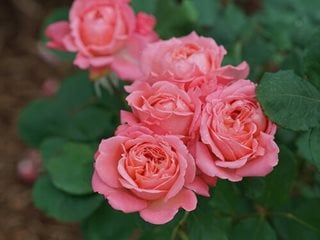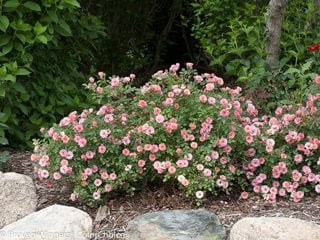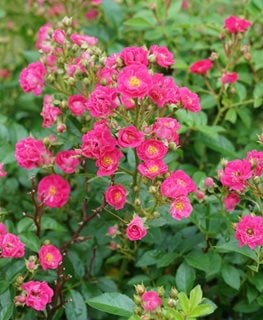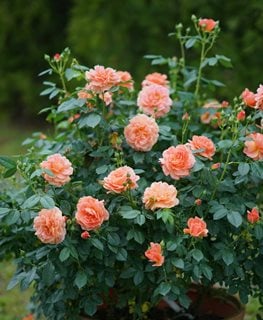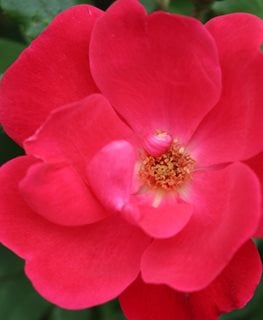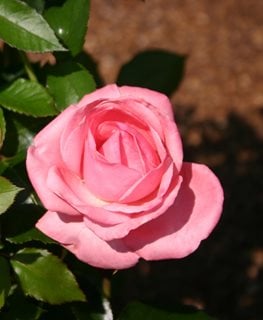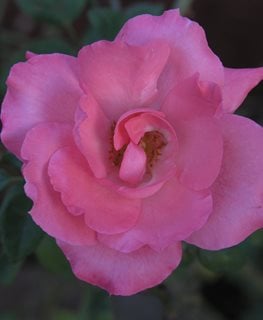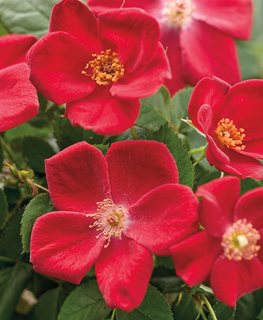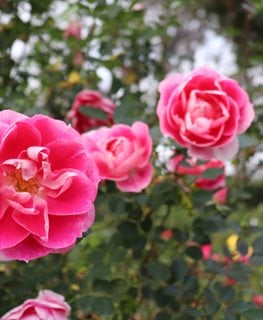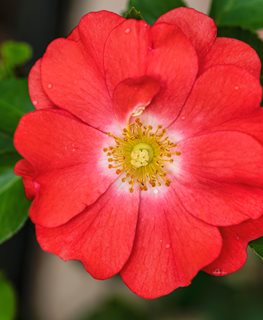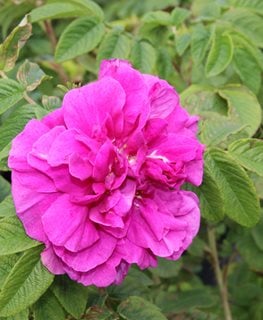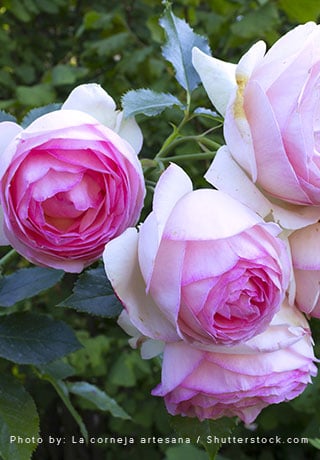EASY SHRUB ROSES YOU CAN GROW
For effortless color, add carefree landscape roses to your gardenRoses have a reputation for being temperamental and difficult to care for. However, not all roses are created equal. Shrub roses are some of the easiest to grow and have the same beautiful attributes of classic roses—but without all the fuss.
Shrub roses come in a wide array of colors, from snowy white to deep purple. Though the flowers aren’t as showy as more traditional hybrid teas, shrub roses require far less maintenance and are more resilient. Newer cultivars have been bred for exceptional disease resistance, hardiness, and a greater number of blooms.
On this page: Basics | Planting | Pruning |Care | How to Choose the Right Shrub Rose | Shrub Rose Varieties | Landscaping Tips
- SHRUB ROSE BASICS
- PLANTING
- PRUNING
- CARE & MAINTENANCE
- HOW TO CHOOSE THE RIGHT SHRUB ROSE
- SHRUB ROSE VARIETIES
- SHRUB ROSE LANDSCAPING TIPS
BASICS
Zones:
3-11
Height/Spread:
Mounding bushy habit, 1 to 20 feet tall and 1 to 15 feet wide depending on variety.
Exposure:
Full sun to light shade; bloom is best in full sun.
Bloom time:
Some bloom once in late spring to early summer, but many modern varieties have two or more flushes during the growing season. Some flower continuously from late spring until frost.
Flowers:
Attractive single or double-petaled flowers, sometimes fragrant, and come in nearly every color except green or blue.
Foliage:
Shiny or dull, green or blue-green in color, with elongated leaves that are pointed with a serrated edge. Branches can be thorned or thornless. Some varieties have attractive fall foliage in shades of red, orange, yellow or purple.
Rose hips:
When the blooms are finished, many varieties develop berry-like fruit called hips, which can be red, orange, pink, or yellow.
Toxicity:
All parts of rose plants are non-toxic to dogs and cats, though some pets can experience mild discomfort when ingesting any plants. Sharp rose thorns can cause internal injury.
Deer resistance:
The blooms and new growth on roses are appetizing to deer. Some rose varieties such as rugosas are less appealing because of the thorns or taste. All rose plants will benefit from protection from deer.
PLANTING
When to plant:
Plant during milder months of spring or fall to avoid heat or cold stress.
Where to plant:
Choose a sunny to lightly shaded site with fertile, well-draining soil that stays evenly moist.
How to plant:
- Loosen soil in the planting area 1-1/2 to 2 feet wide and deep. Work a generous amount of compost or cow manure into the soil.
- Dig a hole big enough to accommodate the root ball. Mix in a handful of bone meal to support root development.
- Place the plant in the hole and spread the roots out. The top of the root ball should be level with the surrounding soil surface.
- Fill in the hole, tamp down soil to remove air pockets, and water well.
- Note: If you live in a cold region and the plant is grafted, bury the graft a couple of inches below the soil to protect it from winter freeze.
Spacing:
Place plants 2 to 5 feet apart depending on the variety, and allow for adequate air circulation to help prevent moisture-borne diseases.
For bare root plants:
Soak roots in water for at least an hour to hydrate before planting.
Planting in containers:
- Choose a pot at least 15 to 20 inches in diameter and 18 to 24 inches deep, with adequate drainage.
- Fill the container with a good quality potting soil. Work in a cup of perlite for drainage and a cup of bone meal to support root development.
- Dig a hole big enough to accommodate the root ball and place so the top of the root ball is level with the soil surface.
- Fill in the hole and water well.
See more on how to grow roses in containers.
PRUNING SHRUB ROSES
Most shrub roses, especially modern varieties, bloom on new wood. These are best pruned in early spring before plants break dormancy or when new growth is just emerging. Wait until all danger of severe cold is past.
- Cut back the entire plant to about 3 feet high to make it easier to work on.
- Remove dead and diseased canes back to the base of the plant, as well as branches that cross.
- Take out branches that are smaller than the diameter of a pencil.
- Cut remaining canes back to 1 to 2 feet high, just above an outward-facing bud. This will encourage new branches to grow outward for a graceful, arching habit.
Pruning modern hybrids:
Some, such as Oso Easy®, need little or no pruning. Lightly shape as needed in early spring. To rejuvenate, remove one-third of older canes every 2 to 3 years.
Pruning heirlooms:
Some, such as Gallica, musk, and rugosa, bloom on old wood and should only be pruned lightly in spring to avoid sacrificing flowers. Cut out dead and diseased canes as needed.
Deadheading:
After the first blooms in late spring or early summer, cut branches just below the spent flowers to encourage rebloom. This can be repeated as necessary throughout the summer. Some modern varieties are self-cleaning, so deadheading is optional, though plants will generally bloom more and have a neater appearance if spent flowers are removed. For varieties with hips, cease deadheading in late summer to allow fruit to develop.
For more, see Pruning Roses: 8 Steps for Healthy Rose Bushes
SHRUB ROSE CARE
Soil:
Roses prefer fast-draining soil that is well-amended with rich organic matter. They do best with a pH level that is neutral to slight acidic, between 5.5 to 7.0, with 6.5 being ideal.
Amendments & fertilizer:
Roses are heavy feeders, though many shrub roses can get by with less fertilizer.
- For new plants: Wait several weeks after planting to begin fertilizing, and avoid harsher granular fertilizers during the first year.
- For established plants: There are many different fertilizers especially formulated for roses, so pick a type and fertilizing schedule that is right for you. Plants benefit from fertilizing in early spring to stimulate new growth. Continue fertilizing every 2 to 6 weeks depending on the type of fertilizer. Stop fertilizing 6 to 8 weeks before your average first frost date to avoid damage to new growth. Mulch in spring with 1 to 2 inches of compost or other organic matter to suppress weeds, retain moisture, and add slow-release nutrients.
For more, see How to Fertilize Roses.
Watering:
Roses need a moderate amount of water to perform their best. Less frequent, deeper watering results in healthier roots. Plants should receive 1 to 2 inches of water per week, depending on conditions. Avoid overhead watering, which can contribute to fungal disease, such as powdery mildew. Irrigate new plants more frequently, 2 to 3 times a week, until established.
Diseases and pests:
Shrub roses, especially modern hybrids, tend to be more resistant to pests and diseases. Possible pests include aphids, mites, thrips, caterpillars, Japanese beetles, scale, nematodes and rose chafer. Diseases include black spot, powdery mildew, rust, verticillium wilt, rose mosaic, crown gall rot, and rose rosette disease.
HOW TO CHOOSE THE RIGHT SHRUB ROSE
For borders and landscapes:
Choose varieties that fit the scale of your landscape. Use as hedging, screening, in a mixed border, or as foundation plantings.
For slopes and hillsides:
Groundcover and smaller shrub roses are suitable for massing along a slope or hillside for erosion control.
For containers:
Choose small-to-medium varieties and plant in containers that are big enough to accommodate the roots.
SHRUB ROSE VARIETIES
LANDSCAPING TIPS
There are many ways to incorporate shrub roses into your landscape. Here’s how:
- Mass a groundcover type along a slope or hillside as an attractive alternative for erosion control.
- Use a low-growing form as a lawn substitute or where difficult to grow grass.
- Plant a larger specimen in the middle or back of a mixed border to lend a neutral backdrop to surrounding plants.
- Plant a smaller variety along a pathway for a blooming hege.
- Site different colored varieties along your home’s foundation in combination with other flowering shrubs such as azalea, abelia and bluebeard that bloom in early spring or fall for continuous season-long color.
- Plant a larger variety such as rugosa rose as hedging along a property line for privacy.
- Medium-sized shrub roses can be planted in a row as a colorful divider between garden rooms.
- Plant a small-medium variety in a container and place as a focal point at your home’s entrance, on a patio or deck. Underplant with colorful annuals for an extra pop of color.
RELATED:
Rose Care: A Beginner’s Guide to Growing Roses
Ideas for Designing a Rose Garden
Tips for Choosing the Best Garden Roses
